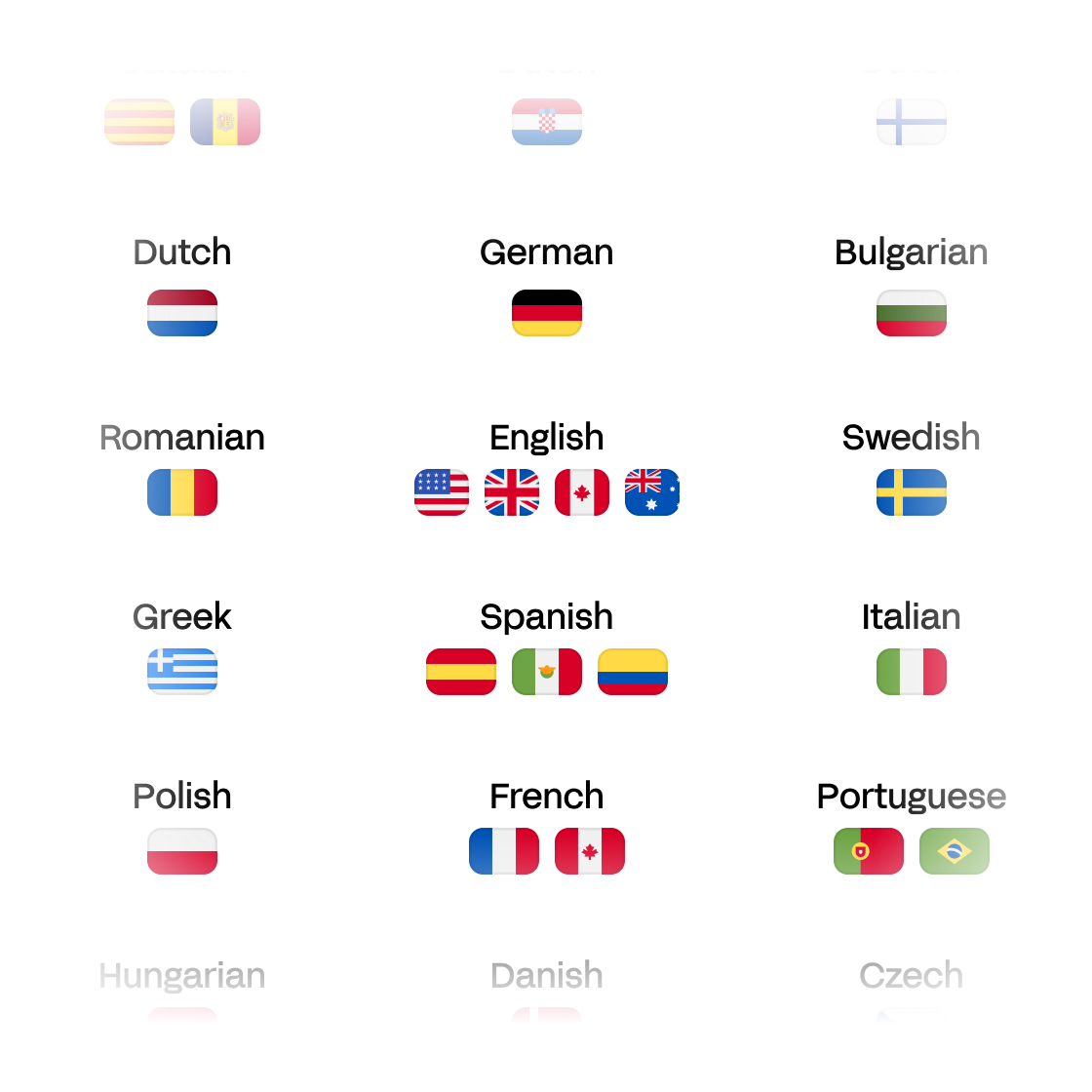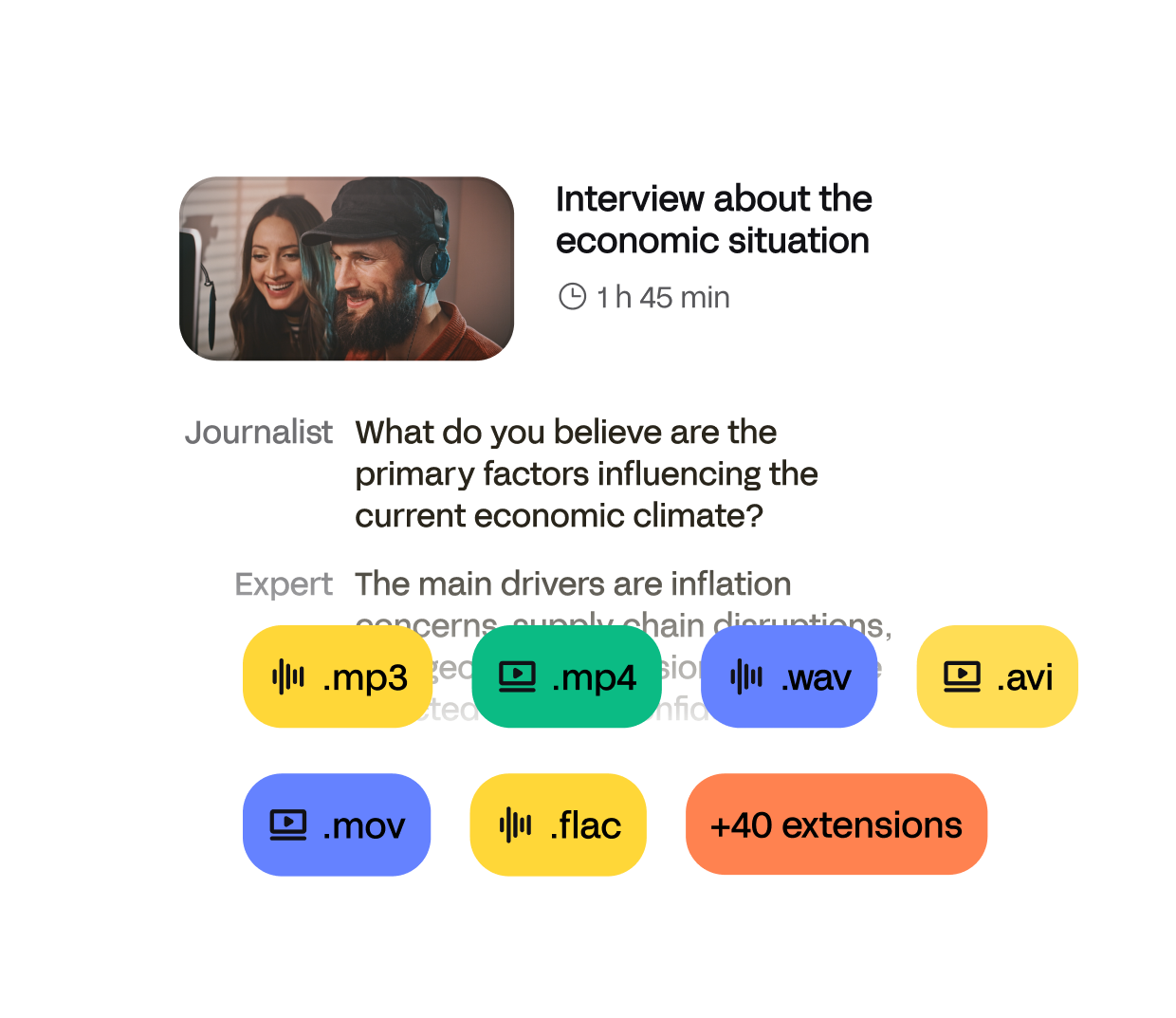
Transcribe 120+ languages
HappyScribe is your partner for transcribing any language from audio to text. We've got the biggest language variety!

Choosing the right AI transcription tool isn’t just about speed: it’s about how well it fits into your workflow.
Businesses and professionals producing global content at a fast pace will also need features for collaboration, multilingual workflows, and subtitle styling to achieve the best results.
If you’re debating between HappyScribe and Sonix, here’s what you should know before deciding.
|
|
 |
 |
|---|---|---|
|
User experience |
✅ Organized and efficient |
☑️ Limited features |
|
Security |
✅ GDPR & Soc 2 Type 2 |
✅ GDPR & Soc 2 Type 2 |
|
Language support |
✅ 120+ languages |
✅ 54+ languages |
|
Workflow |
✅ Designed for teams |
☑️ Basic setup with limitations |
|
Use cases |
✅ Supports every need |
✅ Best for small projects |
|
Team collaboration |
✅ Yes |
☑️ Limited |
|
AI assistant |
✅ Yes |
☑️ No |
|
Glossaries |
✅ Yes |
✅ Yes |
|
Subtitle styling |
✅ Yes |
☑️ Limited |
|
Subtitle editor |
✅ Yes |
☑️ No |
|
SDH subtitle compliance |
✅ Yes |
☑️ No |
|
File format type |
✅ Yes |
☑️ No |
|
Pricing |
✅ Pay-as-you-go and starting at 9 USD per month |
✅ Pay-as-you-go and starting at 16.50 USD per month |
HappyScribe offers AI-powered language services tools for professional and global content production. HappyScribe can help with audio-to-text transcription, translation, and subtitling with features that create a consistent workflow and collaboration across large-scale teams.
Key features of HappyScribe include:
Each of these features and more makes HappyScribe a top choice for professional use, such as within media teams, while producing marketing materials, or for e-learning materials.
Sonix is another AI-powered transcription, translation, and subtitling tool. It offers basic features to help users generate automatic outputs across 54+ supported languages.
The key features of Sonix include:
While Sonix offers basic features, it’s limited in several aspects when compared to HappyScribe. For example, its options for subtitle styling and multilingual workflows have notable shortcomings while producing global content at a larger scale. We’ll dive into the details of those aspects in the rest of this article to show you the pros and cons.

Several advanced features contribute to an organized and accessible user experience while using HappyScribe. Those include:
You’ll find each of these features within an organized workflow on the platform. When you log in, you’ll clearly see where to go to create transcripts, upload files, and customize the outputs based on your needs.

Sonix provides a simple and accessible interface to generate transcripts, translations, and subtitles. However, you’ll find that some of the features are more basic when comparing it to HappyScribe.
Essential elements that contribute to the user experience on Sonix are:
While the interface on Sonix is simple and clean, it feels more basic compared to what you get with HappyScribe. Professional teams creating content may find that adjusting settings feels clunky, proofreading takes longer, and you don’t get all the AI prompting options like you do with HappyScribe for a faster workflow.
HappyScribe generates AI-only outputs with 95% accuracy and offers an expert proofreading option that boosts accuracy up to 99%. AI-only outputs are generated in minutes, and you’ll receive expert proofreading within 24 hours with the option to add rush orders for expert proofreading when you’re approaching a deadline.
HappyScribe is a trusted and accurate choice for professional content creation because it’s continuously tested and optimized to improve its capabilities. It’s trained and tested daily on 12,000+ hours of content each year.
Additionally, HappyScribe’s Glossaries feature will improve accuracy. When you have words that commonly get misspelled, such as names or company-specific terminology, you can add them to your glossary to ensure the outputs include the correct spelling.
Sonix has unverified accuracy rates, so it’s hard to tell how precise its automatic outputs are. The best Sonix does is estimate its accuracy after you generate a transcript or translate text, but those numbers are inconsistent.
Sonix also doesn’t offer an expert proofreading option to take that task off your hands, so someone from your team will have to manually review and edit outputs each time.
The one area where Sonix does compare to HappyScribe is that it offers a Custom Dictionary feature that operates similarly to HappyScribe’s Glossaries. You can add commonly misspelled words to the Sonix dictionary from the settings menu or right within the editor.
However, while comparing everything that contributes to accurate outputs, Sonix still has several inconsistencies that make its accuracy fall short during professional use.
HappyScribe can transcribe and subtitle in 120+ languages, and translate in 65+ languages with AI-only outputs. You can also get expert human subtitle translations in 85+ languages with 99% accuracy.
Several advanced features contribute to an accurate and organized experience while creating global content in multiple languages:
These features work together to help teams produce content on a global scale while providing a consistent and localized output.
"Before using HappyScribe, we were only reaching a limited segment of foreign audiences. Our content wasn’t optimized for global viewership because translations weren’t easily manageable."
Samuel Rostein, Channel Manager at Logicomix
Sonix offers transcription and translation in 54+ languages. Again, it has unverified accuracy rates and doesn’t have human translation features to help with review and improve accuracy.
The lack of human proofreading means you’ll need to find fluent or native speakers in different languages to help proofread outputs to ensure they’re accurate before publication, which is often a constraint for many organizations.
Sonix also lacks language support in several major languages across the world. For example, Sonix doesn’t transcribe or translate in:
It’s important to check the language capabilities of any transcription and translation tools you’re considering to ensure they cover the audiences you plan to create content for.
|
|
 |
 |
|---|---|---|
|
English |
✅ Yes |
✅ Yes |
|
Albanian |
✅ Yes |
☑️ No |
|
Hindi |
✅ Yes |
✅ Yes |
|
Spanish |
✅ Yes |
✅ Yes |
|
French |
✅ Yes |
✅ Yes |
|
Bengali |
✅ Yes |
✅ Yes |
|
Russian |
✅ Yes |
✅ Yes |
|
Portuguese |
✅ Yes |
✅ Yes |
|
Mandarin Chinese |
✅ Yes |
✅ Yes |
|
German |
✅ Yes |
✅ Yes |
|
Japanese |
✅ Yes |
✅ Yes |
|
Swiss German |
✅ Yes |
☑️ No |
|
Javanese |
✅ Yes |
☑️ No |
|
Tamil |
✅ Yes |
✅ Yes |
|
Nepali |
✅ Yes |
☑️ No |
|
Afrikaans |
✅ Yes |
☑️ No |
|
Vietnamese |
✅ Yes |
✅ Yes |
|
Turkish |
✅ Yes |
✅ Yes |
HappyScribe’s workflow is designed to facilitate collaboration among team members while producing content at a fast pace. Several advanced features contribute to making that possible:
Sonix offers basic features to share project access with your team, organize files into folders, and automatically add speaker labels.
The platform generally provides an organized system. However, there are some instances where the workflow doesn’t feel as smooth.
For example, some important settings can feel hidden within the menus, such as the option to remove speaker labels. When you generate a transcript with Sonix, it will add speaker labels by default. Then, if you want to remove them, you have to go through a couple of menus to change the setting. Cases like that can add unnecessary complexity.
The other main drawback is that the subtitle editing options feel more limited in Sonix. You can adjust the font, size, and color of subtitles and add them right into your video file. However, the final output tends to look more blocky compared to the natural feel that you can create with HappyScribe.
Sonix also doesn’t offer automatic subtitle syncing, so you’ll have to adjust their timing manually, which will add extra steps to your workflow.
HappyScribe makes security a priority for businesses and professionals who want to ensure their information is protected while using a transcription tool.
As a European-based company, HappyScribe is fully GDPR compliant. All data on the platform is stored, processed, and managed with high privacy standards.
Additionally, HappyScribe is SOC 2 Type 2 compliant and offers secure single sign-on (SSO) login.
Sonix also takes its security seriously to protect user data and information.
Sonix is GDPR and SOC 2 Type 2 compliant, and offers SSO login with its enterprise plan.
HappyScribe offers both a pay as you go option and monthly subscriptions at different tiers. They go as follows:
You can also get a 33-34% discount when you sign up for an annual Lite, Pro, or Business plan.
Additionally, you can start with a free trial to test HappyScribe before paying.
Sonix offers a standard pay as you go option at $10 per 60 minutes or a Premium monthly subscription at $22 per month. You can also get a 25% discount on the Premium subscription with an annual plan.
Additionally, you can get an Enterprise plan with Sonix at a custom price based on the number of users you plan to add and what your expected transcription and translation needs will be each month.
HappyScribe is a top choice for businesses and professional content creation. It creates an organized system for collaboration across large teams, multi-language workflows with 120+ supported languages, and precise subtitle styling. It’s continuously tested and optimized to improve its capabilities and ensure high-quality results.
Best use cases with HappyScribe include:
Sonix is best for occasional smaller projects and personal use where collaboration, subtitle styling, and multi-language workflows aren’t as high of a priority. While Sonix offers a clean and simple interface, larger teams producing global content may find that its language capabilities and features feel too limited for professional use.
HappyScribe is the AI transcription, translation, and subtitling option that comes out on top for professional business use. Some key features that make it stand out while comparing it to Sonix are:
Sonix offers an accessible platform for transcription and translation that’s overall easy to use, but it falls short in the categories above when you need a reliable and organized solution for professional use.

HappyScribe is your partner for transcribing any language from audio to text. We've got the biggest language variety!

Convert any MP3, WAV, FLAC and more into text. HappyScribe goes beyond simple .txt file exports and offers full transcription workflows.

Your audio transcripts are safeguarded with SOC 2 and GDPR security measures, for optimal data protection.